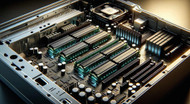When configuring memory in Hewlett Packard Enterprise (HPE) servers, understanding the concept of memory rank is crucial. Memory rank refers to the organization and density of memory chips on a module, and it plays a significant role in the server's performance, compatibility, and power consumption.
Types of Memory Ranks
Memory ranks vary in terms of the number of sets of memory chips they contain:
- Single Rank (1R): Contains one set of memory chips. It offers lower latency but has a lower capacity.
- Dual Rank (2R): Includes two sets of memory chips, with a balance between capacity and latency.
- Quad Rank (4R): Comprises four sets of memory chips, suitable for higher capacity needs but with higher latency and power consumption.
- Octal Rank (8R): Features eight sets of memory chips, maximizing capacity at the cost of even higher latency and power usage.
As you move from single to octal rank, memory density and capacity increase, but this also leads to higher latency, power consumption, and potential compatibility issues. The choice depends on the server's requirements and capabilities.
Why Opt for Lower Rank Memory in HPE Servers?
In some scenarios, installing lower rank memory, such as single or dual rank, is more advantageous in HPE servers:
- Compatibility and System Support: Some HPE servers may only support up to a certain memory rank, making lower rank modules necessary for compatibility.
- Performance Considerations: Applications sensitive to latency can benefit from the lower latency offered by lower rank modules.
- Power Consumption: Lower rank modules consume less power, which is crucial in power-sensitive environments.
- Cost Considerations: Lower rank modules are often more cost-effective, especially when high capacity is not a priority.
- Heat Dissipation: Lower rank modules generate less heat, an important factor in dense server environments.
- Memory Channel Population: Using lower rank modules may allow for more modules to be installed without exceeding the memory channel's load limits.
Choosing the right memory rank involves balancing the server's memory capacity and performance needs with factors like power efficiency, cost, and cooling requirements.






